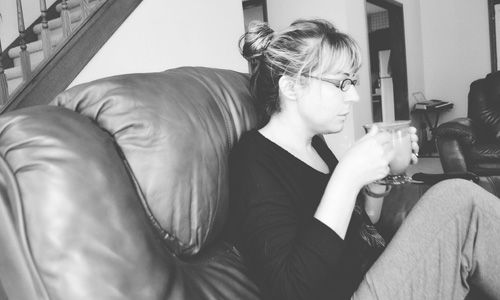My Blood Sugar Solution detox phase removed all caffeine, sugar, dairy & alcohol from my diet. After 3 days of caffeine withdrawal I was physically fine, but still emotionally longed for my coffee.
The. Entire. Six. Weeks.
I had a total of 4 dreams about coffee. Which is really rather eye-opening considering I couldn’t be physically dependent on it. It has clearly become a comfort object, like a special blankie for an adult. I had no intention of reintroducing sugar or processed foods back into my diet, but I was counting down the days till I could have my coffee and some organic cream back. (I have sworn off flavored creamers. Yes, I miss them a bit. No, I am not having Coffeemate dreams.)
I even installed an app on my phone that gave me a day/hour/minute/second countdown.
My plan was to stick with decaf, or even half-caff, till I had a conversation with someone about how the decaffeination process actually works. There are a few ways, actually. Some involving nasty solvents like methylene chloride and ethyl acetate that strip away the caffeine modules from the coffee bean. Alternatively, there is a chemical-free method called Swiss Water Processing. Basically, the beans are soaked in hot water and then run through a carbon filter. Read a little more about this process here and here.
Sadly, not very many companies use SWP for their decaf blends (cost, perhaps?). But, HAPPILY, my favorite drive-through coffee shop utilizes it. Thank you, Tim Hortons! The Swiss Water search also pulled up Seattle’s Best, which is what I drink at home. I was a little confused though, because companies using SWP are supposed to have a little logo on their packaging, which the Seattle’s Best #3 blend doesn’t have. I did a little more poking around and noticed that the decaf on the approved list was Seattle’s Best ‘Twilight Blend’. So, I sent an email to SB’s customer care and got a friendly, informative response back by the end of the day.
“The Seattle’s Best Signature Blend #3 decaffeniation process is not done via the Swiss water method. As you had mentioned in your email the Twilight Blend is decaffeinated via Swiss water method. We also can offer Decaf Sumatra, Starbucks VIA® Ready Brew™ Decaf Italian Roast as these are also done via the Swiss water method.”
(Hold the door… SB is owned by Starbucks? How did I not know this? <hanging head in shame> )
Now I shall go forth, armed with this new information, and shop for coffee. And then probably experiment with some of these coffee beverages. Not a bad addition to my to-do list!
This iced coffee from Sarah Bakes

This Pumpkin Frapp by Sally’s Baking Addiction

And I definitely need to do this!

Have you checked out my Instagram feed yet? It’s my favorite place to hang out during the day! You can keep tabs on what I’m up to, cause you know… I’m cool. (and clearly practicing self-affermation)


I’m not a coffee drinker (love the smell, but not the taste!)…I’m a tea drinker – unsweetened, usually black, but some green. I sometimes drink decaf tea in the evenings…I wonder if it goes through a similar process.
LikeLike
Probably not. Speaking off the top of my head, I believe that the caffeine level depends on the type of plant and the stage of growth it’s in when picked. I could be totally wrong, lol! Now I’m getting curious myself. Let me know if you find anything out!
LikeLike
This is what I found on one site: Currently, there are four methods of decaffeination: methylene chloride, ethyl acetate, carbon dioxide, and water processing. In the United States, ethyl acetate is the most widely used decaffeination method.
I guess it would be a good idea to investigate each tea individually to see what method they use.
LikeLike
Interesting. I thought tea was only naturally caffeinated or not.
LikeLike